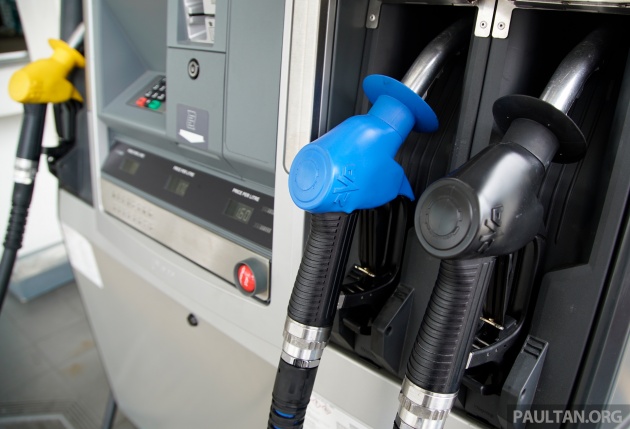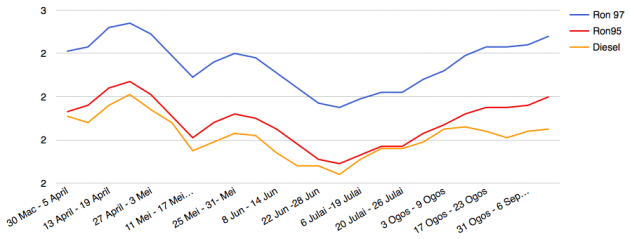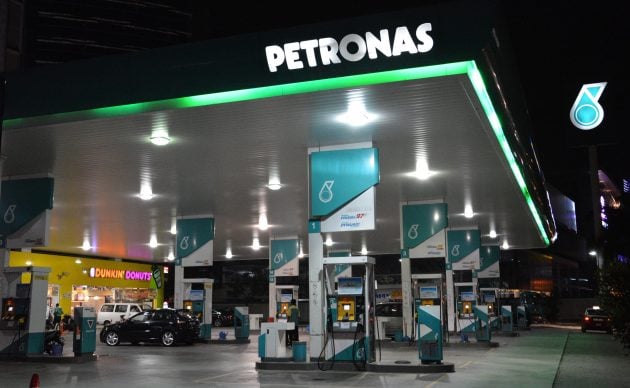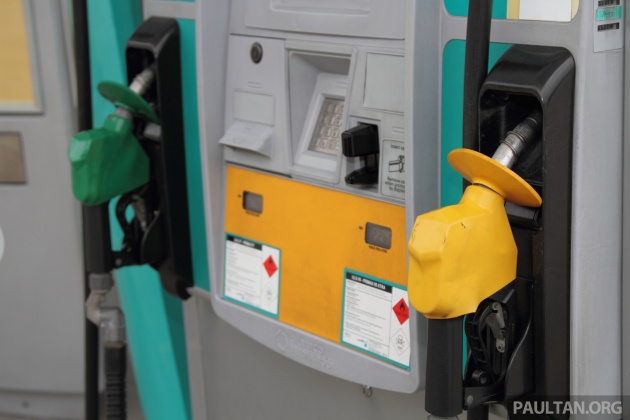The Automatic Price Mechanism (APM) that has been in place since 1983 to regulate the price of fuel in Malaysia might soon see some change. The government is mulling a review of the APM in the second half of 2018 after consultation with stakeholders, The Star reports.
Before you start thinking of lower fuel prices, the stakeholders in question here are petrol station operators, who are not happy with the way APM has been administered since the implementation of the current managed float system, which replaced subsidised retail fuel products in December 2014. They claim that the new system has resulted in fluctuations of petrol prices and inventory levels.
According to the daily, the government’s move to deregulate retail fuel prices in the last three years has caused discrepancies in the highly structured agreement between petrol station operators and the oil companies.
The issues caused has resulted in a rising number of stations closing down. Petrol Dealers Association of Malaysia (PDAM) claims that around 120 stations nationwide have stopped operating over the past three years. There are a total of 3,500 petrol stations nationwide.
The Petronas Petrol Station Operator Association says that 57 Petronas stations have closed over the past three years, a big jump from the seven shuttered ones from 2012 to 2014. Shell Petroleum Dealers Association Malaysia shared a similar trend – 45 stations have closed down over the past three years, from seven between 2012 to 2014. A total of 16 Petron stations have closed down in the same period.
What does the government have to say about this? Domestic trade, cooperatives and consumerism minister Datuk Seri Hamzah Zainudin, in a recent interview with StarBiz, refuted the figures from the petrol station dealer associations, saying that there have been fewer operators closing down. He however acknowledged complaints by station operators on their powerlessness to control the stock level purchased by oil companies.
“When I look at the complaints, there are more towards the misunderstanding between oil companies and dealers (operators),” Hamzah said, adding that moving forward, the ministry is seriously looking to review the current APM by examining the stock level complaints by operators to create a fair deal between both operators and oil companies.
“I am looking to resolve this. I have to come up with a formula to create a win-win situation for both operators and oil companies. It will be in the second half of next year. Oil prices are rising now. So it is scary to say, if I really take a stand for the operators, it will create higher inflation,” he said.
PDAM president Datuk Khairul Annuar Abdul Aziz explained the situation. He said that station operators are using profit gained on the stock purchased at the lower cost to buy back more expensive stock, and this has expedited the surrendering of petrol station licences.
“Let’s say, we have overdraft facilities for the working capital, and now our stock price is higher, we need to pay higher interest for the increased working capital. Otherwise we need to pump our own funds from outside, losing out on potential interest earned elsewhere (opportunity cost). As we speak, dealers are preparing their surrender letters. It is not worth to continue pumping in more money,” he stressed.
Khairul expects more operators to leave the industry as they fall into bankruptcy. “There are many cases of operators becoming bankrupt now. They tried in vain to hang on by resorting to more loans, including from loan shark, in hope of a review in APM as cost has caught up and operator’s commission stagnant since 2008,” he said.
The English language daily found an example in Petronas station operator Sitti Satmawati, whose losses hover around RM150,000 since the introduction of the weekly fuel prices in March 2017. “The losses made are my working capital. Overtime, the working capital will be eroded, then what do you do? You don’t have enough cash to pump in again,” she said, adding that station operators also absorb the 1% on merchant charges for credit card transactions.
Here’s an explanation on what goes into the Automatic Pricing Mechanism and how retail fuel prices are calculated. Click here for more.
Looking to sell your car? Sell it with Carro.















Nxt year 2018? Gud luck current govt.
either fully regulate across the entire value chain, or completely liberalize and let petrol stations set their own prices based on their own P&L. Give space for operators to figure it out on their own and they will. Or, control everything like it always was.
Liberalizing retail price is not really a good idea in Malaysia. Because Malaysian sellers tend to do price gouging. They rather have an agreement to keep price high than exercising price warfare.
You’ll never know until you try it out.
Be smart and choose Perodua cars.
Jimat minyak, tak pening kepala, tidur malam pun lena.
OK..look at this scenario
Today Rm2.30 say(per litre)
Next week rm 2.40
Lagi nex next week rm2.45
Every price increase will benefit the operator.
Say,before midnight each wed…the PDAM operator has 5 old price tankful delivered.So tell us,MR PDAM ,how can there be losses?
70 percent of the time,there is increase in pricing.
You need a PHD in rocket science to do the math?
Just pathetic and shambolic.
The rakyat got problems putting food on the table,not listening to these junk garbage pathetic stories,YAB menteri.
Meanwhile VW habis jual in 20 minutes. Whats this about MY pipu being poor nonsense?
Hi Albert, am in the industry but not as a retailer (dealer) myself. What the public do not understand are the following:
1. When price goes up the following happens:
– Cost of stock goes up, hence capital cost increases
– Credit card charges absorbed by the dealers on behalf of consumers are around 1% whenever we as consumers pay using credit card. The higher the pump price, the more the dealers have to pay out in terms of credit card charges. Plus there are more customers buying with the credit card when the pump price is high.
– Customers buy less liters of petrol/diesel as they have the same budget. So if you buy RM50 per week before, you still only have RM50 to spend. That means you purchase less litres and plan your journey to accommodate. The dealers make fixed amount of of commission per litre sold, less sold, less income.
– The increase in price will be deemed as paper gain, lower cost, sell higher price, but stock is for a few days. However, the gain is never enjoyed as it needs to be used to purchase the higher priced new stock.
2. When price goes down, the dealers lose out on stock. And when their hands are tied and not allowed to manage the stocks, when they are sent max stock before price fall, they make a lot of losses. Otherwise, the opposite to the above happens. (Lower price, higher quantity sold, less credit card charges etc).
3. The issue that was faced by the dealers was specifically due to govt policy to change the mechanism in March 2016 and Dec 2014, which led to huge price fall (Gap was big between world price and pump price). That price fall of around 30 sen each time wiped out tens of million of Ringgit in terms of capital, which hit the dealers hard. The following fluctuations were small in quantity and was not too bad. The issue is the timing and implementation of the mechanism that was poor.
Ultimately the current mechanism is a hybrid. The cost and margin is fixed by the government. Fluctuation and higher price (with subsidy taken away) creates losses because the dealers are not allowed to determine their own stock and prices. The mechanism should be either allow dealers to determine stock and price to adjust to world price, or to regulate the price to take out the losses due to fluctuations and the lack of stock determination by the dealers. Free float (which is what many developed non producing nations practises) will be one solution, but may create extremely high price at the pump if the world price climbs up, or regulate and maintain low prices for the benefit of the dealers and consumers in general.
Basher says “ini semua salah world crude oil prices naik turun… oh wai”
Why u so worry
Cry babies…! When are these operators going to understand and buck up… oil fluctuates every day. That is never gonna change. U’re happy well rosy when Govt subsidies the prices… but scream out unfairness when u lose out when going by market rates. Stay in the business if u can handle it… if not close down. As Bob Dylan’s song goes… ‘Times they are a changin’
no matter how the gov review it, citizens always at the losing end and pay more.
When a business is founded from corruption, this will happen.Maybe some are legitimate but just try and see how much you have to ‘pay’ to open one petrol station.
These jokers are not the real businessman,just pretenders.
Real business operator dont conplaint,they find way around the situation.
Do you classify petrol station owner as high, middle or low income group?
Majority of the dealers are low income, as most run small volume stations. What you see in the sub-urban areas or highways are not the norm, they are high volume stations which are not suffering.
Around 60% of station operators are low volume operators, and used to make around a few thousand ringgit a month, maybe around RM3k to RM8k. However, when price fluctuations causes losses, they no longer have the ability to sustain, as their capital keep on shrinking.
Petrol stations give employment to around 50k workforce, and apart from Urban and Highway areas, 80% of these work force are locals. According to Frost & Sullivan, there were 3500 stations operating back in 2014, but now only around 3200 stations. This trend will result in unemployment and disrupts the supply of fuel to the market.